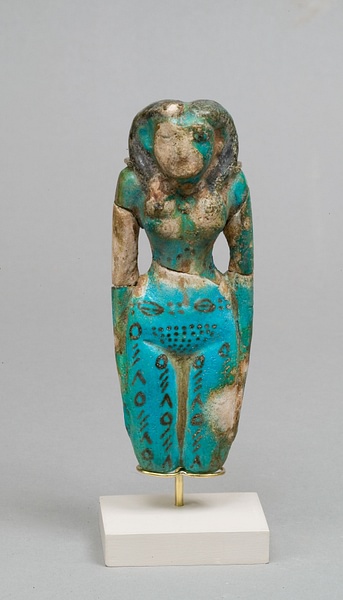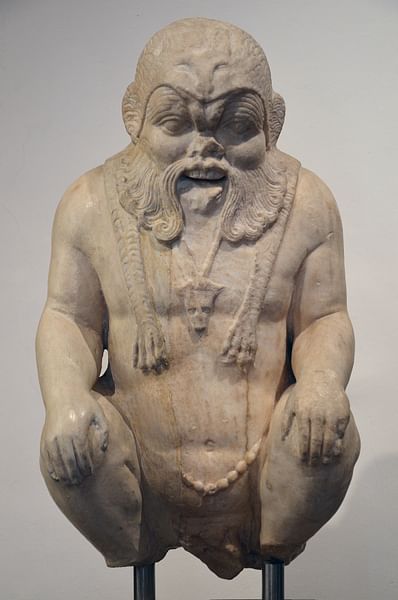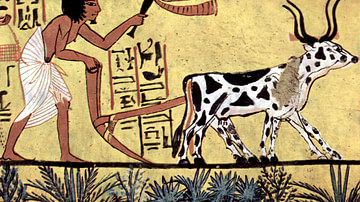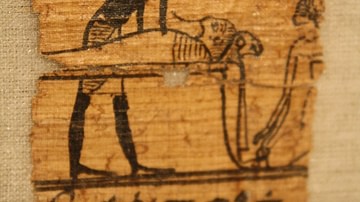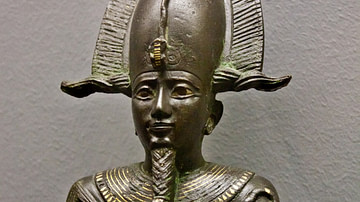Tattoos are an ancient form of art appearing in various cultures throughout history. One of the earliest (and possibly the oldest) pattern of tattoos in the world was discovered on the frozen remains of the man known as Otzi the Iceman who was buried in a glacier on the Austrian-Italian border c. 3250 BCE and discovered in 1991 CE. Otzi's body has 61 tattoos covering him from his lower legs to his upper back, torso, and left wrist. These tattoos have been interpreted as therapeutic in nature, alleviating some condition he may have had, but certainly could also have served other purposes.
The word "tattoo" comes from the Polynesian Ta meaning "to strike" which evolved into the Tahitian word tatau meaning "to mark something" and so tattoos have come to be associated in the modern day with Polynesia. The art of tattooing goes back millenia, however, and was practiced in ancient Egypt at least as early as the Middle Kingdom (2040-1782 BCE). In ancient cultures such as Greece and Rome the tattoo was worn as a cultic symbol dedicating one to a certain god, as a brand symbolizing servitude, as a mark of a certain type of profession (such as a prostitute) or to encourage fertility or afford protection. In these cultures both men and women were tattooed but, in Egypt, tattoos were seemingly only worn by women though possibly for many of the same reasons.
An interesting difference, however, persists in the interpretation of Egyptian women's tattoos as opposed to those of other cultures: the tattoos of Egyptian women were - and are - regarded, when they are not simply ignored, as a symbol of the lower class and the mark of a dancing girl or prostitute without considering other possibilities. Further, even when such options for interpretation are allowed, they must argue against this earlier understanding.
The Confusion
Early Egyptologists interpreted these tattoos according to their own understanding and prejudices concerning body art and, in examining the female mummies or feminine statuary, concluded that tattoos were worn by lower class prostitutes and dancing girls. Joann Fletcher, a fellow in the department of archaeology at the University of York, explains the confusion caused by the assessment of these early interpretations:
Because this seemed to be an exclusively female practice in ancient Egypt, mummies found with tattoos were usually dismissed by the (male) excavators who seemed to assume the women were of "dubious status," described in some cases as "dancing girls." The female mummies had nevertheless been buried at Deir el-Bahari (opposite modern Luxor) in an area associated with royal and elite burials, and we know that at least one of the women described as "probably a royal concubine" was actually a high-status priestess named Amunet, as revealed by her funerary inscriptions. And although it has long been assumed that such tattoos were the mark of prostitutes or were meant to protect the women against sexually transmitted diseases, I personally believe that the tattooing of ancient Egyptian women had a therapeutic role and functioned as a permanent form of amulet during the very difficult time of pregnancy and birth (1).
As more evidence came to light of tattooed women who were obviously priestesses and members of the court, the interpretation of "low class" tattooed women was somewhat revised to include the concept of cultic tattoos identifying a woman with the worship of Hathor. This understanding still carried with it a sense of eroticism and sexuality, however, which a present-day sensibility cannot seem to include in the definition of a priestess. Even in the modern-day "progressive" society, these ancient tattoos continue to be associated broadly with lower class members of society just as they were in the 19th century CE. Although the precise meanings of ancient Egyptian tattoos may be unclear, it seems evident that they had an array of implications and that women of many different social classes chose to wear them.
Tattoos In Egypt in the Middle Kingdom
Tattoos in ancient Egypt may date back to the Pre-Dynastic Period (c. 6000 - c. 3150 BCE) based on evidence suggesting priestesses of the goddess Hathor would have had themselves so marked at that time. This claim is purely speculative, however. The most conclusive evidence of Egyptian tattoos found thus far dates the practice to the Middle Kingdom. Scholar Carolyn Graves-Brown writes how, "in 1891, two ancient Egyptian female mummies were uncovered from Middle Kingdom Deir el-Bahri; they bore tattoos of geometrically arranged dots and dashes" (113). She goes on to note that the tattoos on these women were the same as those found on Middle Kingdom fertility dolls and that, further, other female mummies were later discovered with similar markings.
The first female mummies uncovered were thought to be members of a king's harem and the others dancing girls or prostitutes. The male Egyptologists of the 19th and 20th centuries CE who were studying the mummies could not reconcile their understanding of a tattooed woman with one of high social standing and so tattoos were considered a mark of the lower classes. Even as recently as 1995 CE, the Egyptologist Joyce Tyldesley, whose treatment of tattoos and women is usually cogent and precise, writes, "Tattooing seems to have been confined to lower-class women" (160). Even though elsewhere in her work she acknowledges the variation in purpose of tattoos, the old stigma of body art carries on in the modern day and prevents people (often males) from interpreting these marks correctly.
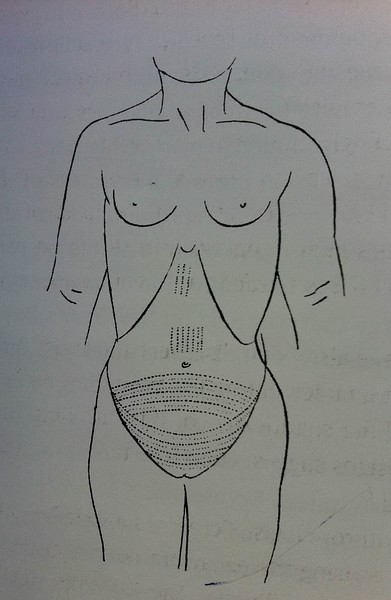
The claim that tattoos were only worn by prostitutes, dancing girls, and "lower-class women" becomes even weaker when one considers the case of Amunet, a priestess of the goddess Hathor from the 11th Dynasty of the Middle Kingdom. The mummy of Amunet, discovered with the others in 1891 CE by Egyptologist Eugene Grebaut at Deir el-Bahri, shows patterns of tattooed lines on her arms, thighs, and lower abdomen. These tattoos are interpreted by some scholars as fertility symbols and this claim is strengthened by other statues and mummies of tattooed women with the same kinds of marks on their body.
Tattoos as Symbolic Protection
These tattoos are thought to have been worn by a priestess to honor Hathor who, among her many duties, was also goddess of fertility. They were worn by other women as symbolic protection of a child in the womb and during child birth (although these are not mutually exclusive since priestesses could marry and have children). It has been noted that, as a woman's pregnancy developed and the belly swelled, the tattoos would have formed an intricate net design from one's lower back to just below one's navel, thus creating a distinctive protective barrier between the world and the unborn child. The protective aspect of the tattoo is further suggested by the figure of the protector-god Bes which women had tattooed on their inner thigh. Joann Fletcher notes:
This is supported by the pattern of distribution, largely around the abdomen, on top of the thighs and the breasts, and would also explain the specific types of designs, in particular the net-like distribution of dots applied over the abdomen. During pregnancy, this specific pattern would expand in a protective fashion in the same way bead nets were placed over wrapped mummies to protect them and "keep everything in." The placing of small figures of the household deity Bes at the tops of their thighs would again suggest the use of tattoos as a means of safeguarding the actual birth, since Bes was the protector of women in labor, and his position at the tops of the thighs a suitable location. This would ultimately explain tattoos as a purely female custom. (1)
No written work on the subject of tattoos survives from ancient Egypt and so interpretation is always speculative but it seems likely these tattoos were not simply adornments to make a woman more attractive to a man but served a higher purpose and, further, this purpose differed in different eras. Graves-Brown writes:
Much confusion also arises from the conflation of New Kingdom depictions of Bes on dancers' legs, with Middle Kingdom marks on the bodies of elite women and `fertility dolls'. All the evidence suggests that the only Egyptians in Dynastic Egypt to have tattoos were women and that these women would be elite court ladies and priestesses of Hathor perhaps decorated to ensure fertility, but not for the simple amusement of men. The origins and precise meaning of the tattoos, however, remain unclear (114).
Bes was primarily a protector god of pregnant women and children but was also associated with sexuality, fertility, humor, and joy in life. His image on a woman's thigh, therefore, could have many meanings within that context and should not be interpreted narrowly as only pertaining to sexual attraction. Tyldesley writes:
Some New Kingdom entertainers and servant girls displayed a small picture of the dwarf god Bes high on each thigh as a good luck symbol and a less than subtle means of drawing attention to their hidden charms. It has been suggested that this particular tattoo may have been the trade mark of a prostitute, but it seems equally likely to have been worn as an amuletic guard against the dangers of childbirth, or even as a protection against sexually transmitted diseases (160).
Egyptologist Geraldine Pinch also makes a point of the many ways in which Bes tattoos could be interpreted, writing, "Bes amulets and figurines were popular for over 2,000 years. Some women even decorated their bodies with Bes tattoos to improve their sex life or fertility" (118). It does seem clear that prostitutes wore tattoos based upon engravings and images such as those on the Turin Erotic Papyrus. The Turin Erotic Papyrus is a badly damaged document dating from the latter part of the New Kingdom (the Ramesside Period c. 1186-1077 BCE). Interpretations of the images range from claims it depicts a brothel, is a satire on sexual mores, or shows the sexual practices of the gods. The brothel interpretation goes directly to the Bes tattoo as a mark of prostitutes in that one of the women in the images is shown with the tattoo on her upper thigh.
It should be noted, however, that this interpretation is by no means accepted by every scholar who has worked with the papyrus nor should one assume that, because a prostitute wears a certain tattoo, piece of jewelry, or article of clothing, that those images, objects, and articles are synonymous with prostitution. Tattoos seem to have been worn by a number of different kinds of women for different reasons.
Tattoo Artists & Tools
The British archaeologist W. M. Flinders Petrie (1853-1942 CE) discovered tattooing tools at Abydos and the town of Gurob dating to c. 3000 BCE and c. 1450 BCE respectively. The Abydos kit consisted of sharp metal points with a wooden handle while the Gurob kit's needles were bronze. Based upon the tattoos on the mummies, the tattoo artists used a dark pigment of dye, most likely black, blue, or green, with little variation.
These colors symbolized life, birth, resurrection, the heavens, and fertility. Although the color black in the modern day is usually associated with death and evil, in ancient Egypt it symbolized life and resurrection. Green was commonly used as a symbol of life and blue, among its many meanings, symbolized fertility and birth. The tattoo artists were most likely older women with experience understanding both the symbols and the significance of the colors. Female seers were commonplace in ancient Egypt, as Egyptologist Rosalie David explains:
In the Deir el-Medina texts, there are references to 'wise-women' and the role they played in predicting future events and their causation. It has been suggested that such seers may have been a regular aspect of practical religion in the New Kingdom and possibly even in earlier times. (281)
One of the principal purposes assumed for the Egyptian tattoos is practical magic and it is probable that women were tattooed by the female seers for this reason. Images drawn for protection, whether on structures, objects, or people, was commonplace in Egypt. Mothers would frequently draw a picture of Bes on their children's palm and then wrap the hand in a blessed cloth to encourage pleasant dreams. Magical amulets, of course, were popular throughout Egypt in all periods. Magic was synonymous with medicine in Egypt and recognized as an important aspect of life. Magical images, then, tattooed on one's skin would hardly have been out of place no matter one's social status.
Interpretation of the Egyptian Tattoo
It would seem, then, that the tattoo served a primarily religious/protective purpose but this is not to suggest the images had no other. The mistake the early Egyptologists made was in assuming that women who had tattoos were solely dancing girls, entertainers, and prostitutes but it would equally be mistaken to assume tattoos were only worn for magical protection, by priestesses to honor their goddess, or for some therapeutic value. The dancer Isadora of Artemisia (c. 200 CE), for example, was known to have a tattoo of Bes on her thigh but had no children and was neither a prostitute nor a priestess.
Whether women were tattooed as early as the Pre-Dynastic Period in Egypt is unclear and any suggestions are purely speculative but, as time went on, the tattoo clearly became an important part of many women's lives. Interpretations of exactly what these tattoos meant to these women is also speculative as it seems clear that musicians and dancing girls did, in fact, have the same types of tattoos as priestesses.
The problem in the modern day is interpreting a "dancing girl" as a polar opposite to a "priestess" as though there were no hint of eroticism or sexuality to religion and no divine aspect to dancing or sex. Egyptian religion was fully integrated into the lives of the people and sexuality was as much a part of those lives as any other aspect. Perhaps, as in the present, the tattoo in ancient Egypt had many meanings aside from amuletic protection or cultic devotion. In the case of the image of Bes, a god known as well for encouraging merriment as providing protection, perhaps it was simply an expression of the joy one found in living one's life.
